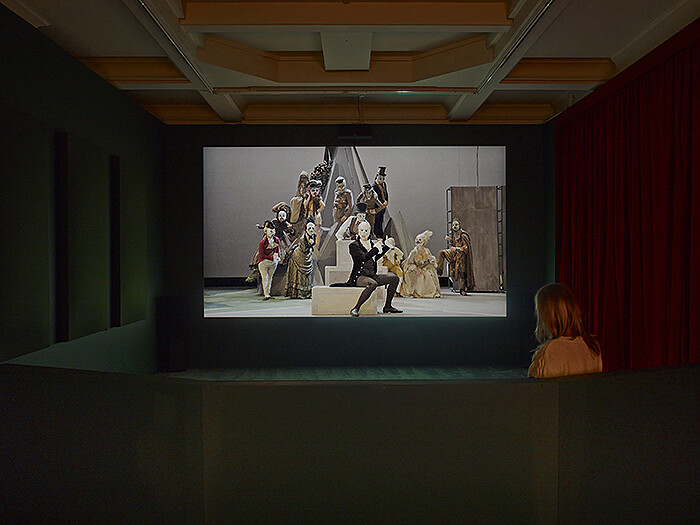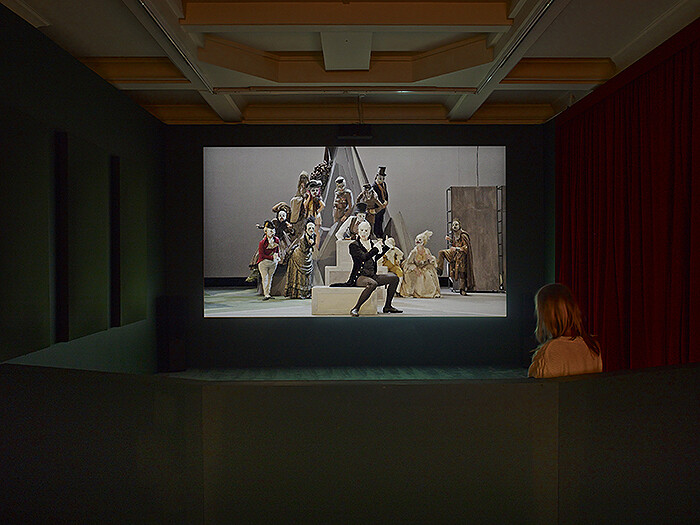Alexandre Singh’s spectacular, ambitious project The Humans (2013) is not the easiest artwork to discuss. A three-hour, three-act play with music-and-dance numbers, The Humans presents the audience with a wildly absurd remix of an origins-of-man narrative, borrowing and stealing from the Bible, the classics, Shakespeare, and other references too numerous and intertwined to keep straight, all presented in a self-conscious fusion of styles—Greek comedy, Commedia dell’arte, and Broadway musical. It tells a tale of the Apollonian and Dionysian dualism at the heart of humanity, and is, to say the least, engagingly bonkers.
Rotterdam’s Witte de With, where The Humans premiered in September last year, and New York’s Performa biennial, where it ran again in October, both commissioned Singh’s work. Here, at commercial gallery Sprüth Magers, a full-length, for-camera performance is projected in high definition, while the rest of the show includes works on paper, sculptures, photographs, and props either preparatory to, or drawn from, the production itself.
The realities of commissioning and production captured in these objects are certainly not trivial. As much as one might enjoy, and perhaps wish to acquire, the static art objects on view, this exhibition hinges upon our understanding of the process behind the kind of artwork The Humans ultimately becomes. The economic and institutional framework of art-making is mixed up in this display with artistic and aesthetic questions about what does and does not inhabit a particular space or venue of presentation—is it performance art? A play? A musical? Do such distinctions matter at all? And even if they don’t, is The Humans any good anyway?
In interviews, Singh is keen to keep things as open as possible, suggesting that while he set out from a basis in visual art, what that space permits nowadays inevitably bleeds into other forms, genres, and audiences. The Humans, then, might be genuinely, confidently post-medium in the sense that it draws on our common, non-specialist appreciation of recognizable forms of theatrical convention embedded in long-range, popular cultural memory.
As a consequence, Singh’s vision of human culture is enthusiastically omnivorous—sucking in everything from Aristophanes to Mozart to sculptor Charles Ray to the Nesquik bunny to Oscar Wilde and Woody Allen (the last four serving as sources for the play’s libidinous matriarch, rationalist patriarch, and their rebellious and conflicted offspring). This all makes The Humans playfully full-to-bursting with pleasure and clever ideas—great costumes, fine acting, good songs, and witty dialogue.
Singh’s approach is also comfortably (and perhaps complacently) postmodern in its pre-modernity, its throw-it-all-in melding of cultural precedents and artistic legacies—boundaries are being blurred and borders crossed in every direction, between genre divisions in the present and in the timeline of changing traditions across history. Demanding that boundaries be observed and traditions respected sounds like the fading lament of the conservative critic, of course. It is more interesting, however, to recognize that what’s at stake in genre- and history-collapsing art such as Singh’s (and you might also find it in the work of Brit contemporaries Pablo Bronstein or Marvin Gaye Chetwynd) is the implosion of the cultural and institutional demarcations that once sustained the specialized histories of the different arts, and kept the “experimental” away from the merely “popular.”
Maybe this is not a bad thing, since artists are at it everywhere: with some previously trained in choreography and dance moving into art (Tino Sehgal, say), or visual artists moving into cinema (like Steve McQueen). Indeed, fences demarcating formal and art historical distinctions seem to be down everywhere. This generalized, cross-disciplinary synthesis of high and low, ancient and modern, might be contemporary art’s belated twenty-first century Gesamtkunstwerk.
However, that’s perhaps being a bit too optimistic. If The Humans gets stuck, it is because it does not really offer something unexpectedly new, but rather the sense of newness that comes when the recognizably old is recombined with itself. It is novel, but weirdly so. This ahistorical position is also hardwired into the narrative of The Humans, since it backdates a distinctly contemporary reading of human nature onto the whole of European cultural history. The Apollonian-Dionysian, desire-rationality theme is only visible through accumulated layers of Friedrich Nietzsche, Sigmund Freud, or Gilles Deleuze—this is how human beings have been, and will forever be. It is an incredibly conventional and familiar reading of ideas about human nature, but such profundities cannot be taken too seriously, since Singh’s method seems inherently skeptical of such grandiose claims to truth, or perhaps offers them only as long as we know to take them as tongue-in-cheek.
It is good to see an artist today care so much about the wealth of past art and culture—and with such evident relish—and The Humans makes you acutely aware of how uncomfortable much contemporary art is when it comes to pleasure, fun, humor, and sensuousness. Yet, while The Humans embraces these, it also tends to collapse any serious distinction between past and present. But if there is no history, then there is no sense of progress (or regression) in art or culture. If one accepts that, it would have a significant effect on the art one decides to make. Archiving, quotation, and recombination are all the hallmarks of contemporary art always hesitating about the future. For better or worse, The Humans delights itself in playing with a present piled high with all the past’s achievements.











